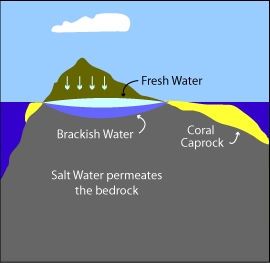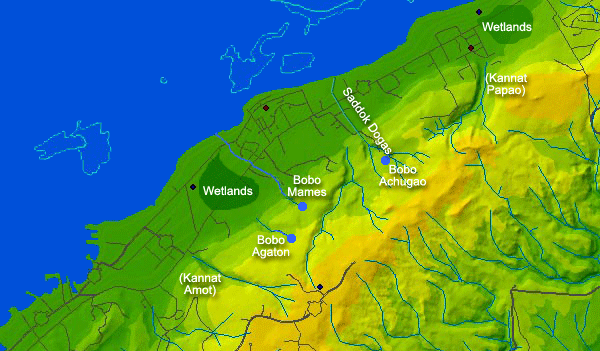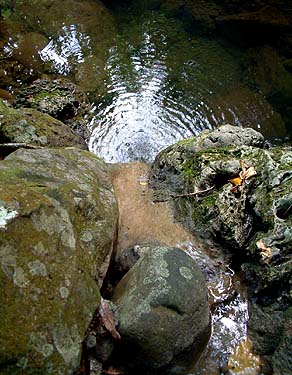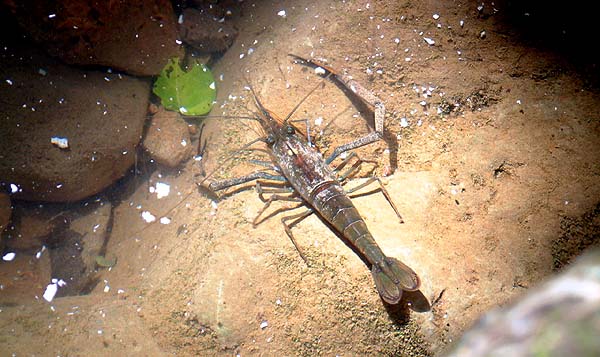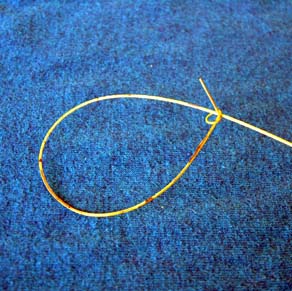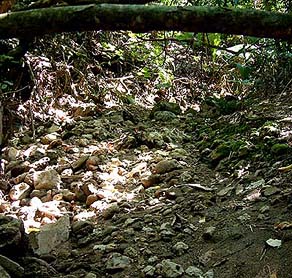 |
 |
 |
|||||
|
|
|
|
|
|
|
|
|
|
|
|||||||
|
|
|
|
|
|
“We have two springs" Ben explains. "One is Bobo Mames or the Mames Spring. Bobo is a spring, a water spring. Mames means ‘sweet.’ So this water must be sweet, it’s not salty. The other one is the Dogas Spring. And then, further down, Agaton. Agaton is the name of one bobo. It is associated with the name of a person, a Chamorro name. Agaton has a spring, but it doesn’t drain out into the ocean; it drains right into the marsh land—the wetland. That’s the distinction between these three. The only streams that drain out to the ocean are the Mames Spring and the Dogas Spring. “The artesian wells up there create streams. Some of them are now dry creeks, but other artesian wells create streams that come out into our area. They drain into the wetlands, and the wetlands kind of filter that water, and then finally the water goes out into the ocean."
|
||
|
|
||
“We call this first river here Saddok Dogas,” Rosa Castro says. “They named it Saddok Dogas, because it has plenty of those small shells, small and white. They stay all around this beach where the river comes out. When you walk up before you go into the river, you can see very many of that kind of shell, around all over the place nearby. "So they say that name because so many of that kind of shell are on the beach where you walk in. That’s all I hear, because even when I walk up here, there are so many shells on the beach. So they call that ‘shell river,’ Saddok Dogas.”
|
|
|
“Because Saipan is of volcanic origin,” Ben says, “you find a few areas that have impervious subterranean solid rocks, like basalt, and that holds the water. And if it’s up in the hill and the water is coming out, we call them artesian wells. But on the flatland here near the shoreline, you just get a regular, drilled well. “The artesian water differs only because they’re up in the hills in pockets. When it rains it replenishes that supply. Artesian water is more potable water, that you can drink. The wells in the lower area are shallow, and are inundated with salt water, so you have a mix of salt water and fresh water. Normally you get the fresher water at the top part of the water lens. If you go down deeper, you’re going to be getting salt water."
|
| |
|
|
“So on occasion, particularly during the year of dry weather, a lot of the water we get is salty. So it’s not potable. Even showering, sometimes it bothers you because you can still feel the salt in the water. We have a very poor water quality throughout the islands."
|
||
|
|
||
“I remember in the village, almost everybody dug wells. Then when you hit the salt water, you stop. But they would line rocks down there so that we can get to the water. That well water is primarily for washing clothes or washing pots and pans. We hardly drink it because it’s saline, though it's less salty than the ocean water. So we normally don’t drink it." “The drinking water actually comes from the rain. Most of our water supply that drains out into the lagoon actually comes during the rainy season. We collect a lot of rainwater through rain catchments, and we use barrels. I have three rain catchments in this house. A lot of people have catchments."
|
|
|
“We’ve used a lot of containers that were dumped by the military, not knowing what they contained earlier. I remember, one time, we had this container, it was lined with lead, and we would collect water and drink out of that. Little did I know that lead is a very toxic element. "The military would have all this lead-covered metal equipment, I guess for radioactive material like for x-ray, and some people found that to be very useful for drinking containers for their cattle, and later on down the years, the cattle were dying. Maybe because of lead poisoning, we’ll never know."
|
|
|
|
|
“These streams actually had water in them when I was growing up. And they have what they call macrobrachium shrimp. We have shrimp and we have freshwater eel. People like to go catch freshwater eel and large-claw shrimp. The shrimp are natives. We call them uhan. It doesn’t matter how big or how small, it’s still uhan. You see one uhan, you see all uhan."
|
||
|
|
||
"These are fresh-water shrimp only. We use scoop net or lasso to catch them. We lasso them at night. We use that coconut frond, and we tie a lasso, and we go in there and lasso them and bring them into our nets. It's hard work, but you know you will get to enjoy eating them during the daytime. Nighttime, we also use scoop nets. We weave nets out of the hibiscus plant and go up there and spend all night catching them." “We have shrimp and eel in most streams up there," Estella agrees. "We catch the shrimp with a net; and the eels, sometimes they use the coconut leaf. They try to lasso them. You put it down and when you see the shrimp come, you pull it."
|
|
|
“You can see eels in the day time because sometimes they come out. They live under the rocks but sometimes they crawl up on the land. You can see them come down the bank. People go to the river and try to catch the eel. Some people that are not scared of eel, they just put down their hand and let the eel bite. And that’s how they catch them. “The eels are freshwater eels," Ben says, "People here enjoyed eating freshwater eels, and so they would go up there and catch the big ones, and we were told when we were young not to kill the eels, because they’re the guys who open up the artesian wells. So we stopped killing them. We believed in those days that the river was running because the freshwater eel opens up the underground well, the artesian well."
|
“When they started harvesting eels for food and sending them to Guam," Estella confirms, "that’s the time that the river from up there stopped coming down anymore to where our house now is at the bottom. "You can still find eels where there’s water. You can still. But the place where they used to get the eels, there’s no more water. Only when it’s raining. But a long time ago, the stream didn't stop. It continued. The stream was running all the time." "We’d catch shrimp in the river, in the stream," Rosa Castro says. "During the Japanese times, this creek never ran dry."
|
|
|
|
|
"We used to go swim up there," Estella recalls, "because it’s very cold. While we were walking up to the stream we felt so hot already because it’s very steep, but going down to the river was not a problem. But when you reach the stream you feel like you’re going to jump inside because you’re so hot already from sweating."
|
||
|
|
||
|
|
|
|
|
|

|
| Tanapag Home | Map Library | Site Map | Pacific Worlds Home |
|
|
|
|

|
|
|
|||
| Copyright 2003 Pacific Worlds & Associates • Usage Policy • Webmaster |
|||


